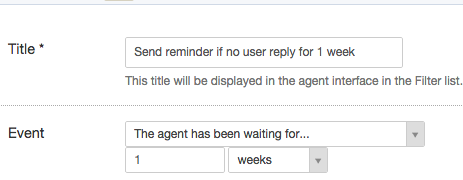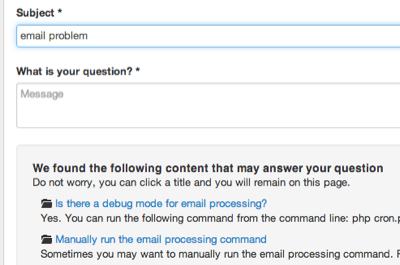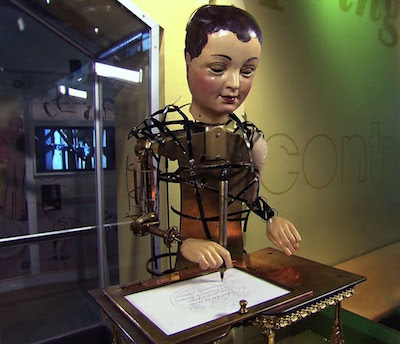"Automation" and "great customer service" seem like two opposing concepts. Many of our worst experiences as customers arise from attempts to remove the human element from a service: endless robotic phone trees with dodgy voice recognition, confusing ticket machines, misfiring text message notifications...

Done right, though, automation can actually improve your customer experience. This post outlines why and how you should be using helpdesk automation.
Why automate?
1. Your human agents are already busy.
Of course, as customers, we all want to feel that an organization we're dealing with offers the "human touch". But your carbon-based helpdesk staff only have so many hours in the day to help customers, and you may not always have as many staff as you'd like. Your helpdesk software can't soothe an angry end-user or troubleshoot a complicated problem, but it can carry out simple tasks instantly.
If you're making your agents spend time prioritising incoming tickets, or sending out routine messages that could easily have been automated, you're burning valuable brainpower that could be better spent actually engaging with your customers.
2. Your helpdesk software works 24/7.
Most helpdesks can't be open around the clock, so your customers or end-users will run into problems when human help is unavailable. Automated responses can reassure a worried customer that you've received their ticket, set expectations for an answer, and even solve the problem by pointing to self-help content like FAQs and troubleshooting guides.
Even if you have the resources to have some agents cover out out-of-hours tickets, or hire agents in multiple time zones, automating business rules is important to avoid confusion between agents from different shifts or locations.
3. Users just want to solve their problem and move on with their lives.
Lately it's become fashionable for #custserv experts to extol the virtues of surprising and delighting your customers, exceeding their expectations and generally rocking their world. But some research indicates that, in reality, customers who have their expectations exceeded aren't any more loyal than those who were simply satisfied.
What really drives customers away is the perceived effort of a transaction: if customers need to contact you multiple times, wait a long time or explain themselves to multiple different agents to get an answer, they will be much more likely to stop using your service. If this research is right, it makes sense to invest in automation to solve the customer's problem faster and with less effort on their part.
What should you automate?
Every helpdesk is different, but in general there are three types of tasks you should automate:
1. Busywork tasks that don't require any decision-making from agents, just time and mindless clicking.
Are you making agents go through old tickets to mark them resolved? Automate it! Even if each agent only spends 5 minutes a day on busywork, over a year, that adds up to two working days wasted: time that would be better spent on actual customer service.
2. Nice-to-have procedures that you 'should be' doing, but...
Your QA team suggests you follow up on resolved tickets where the user gave a bad rating but no comment, and ask them for more information in exchange for a discount coupon. Great idea, but there are so many open tickets to get through... This is the kind of idea you shoud automate.
3. Business rules that sometimes don't get followed.
Are you relying on agents to remember to carry out rules like "always copy in manager B on tickets from organization C"? Automate it! Sometimes a rule like this requires human judgement, but still requires the agent to carry out several steps once the decision is made. Explore the use of macros or triggers to speed up the process, so the agent makes the decision, clicks once, and moves on.
A well-designed helpdesk software platform will offer you a wide range of flexible automation options. Even fairly complex rules can be automated, as long as you can boil them down to combinations of ticket and user properties.

5 common tasks you should automate
1. Follow up if a user stops replying.
When a user stops replying without confirming that the problem is resolved, it's a good idea to follow up and check what happened. Did they not answer because your last response solved their issue, or because they've been busy, forgotten about it, or given up in despair?
You should send a custom follow-up email once you've been waiting for the user for, say, a week, and prompt them to reply again or mark the ticket solved. This lets the customer now you're dedicated to making sure their problem is really solved. It also avoids tickets hanging around in limbo for too long, needlessly driving up your average ticket resolution time.

2. Let users know that their ticket is being dealt with by a real person.
Often there's an unavoidable delay between a user creating a ticket and the first reply from an agent. Between these two events, the ticket will usually be assigned to an agent.
You can use automation to inform the user when this happens, providing reassurance that the ticket they sent hasn't disappeared into the ether. You probably don't want to send an email every time the ticket is assigned to a different agent, though, just the first time.
3. Filter bounce messages and 'out-of-office' replies.
Inevitably, automatic messages get turned into tickets. Deleting these is busywork and should be easy to automate using title matching. A more advanced helpdesk may even include automatic detection of bounces and automated messages to make it even easier to set up the automation.
4. Answer tickets before they're created.
Any modern helpdesk software platform will offer a ticket deflection feature, which shows customers suggested solutions based on their query.
This requires some investment of time to build up your Knowledgebase, but even a few hours spent writing up answers to your top 10 most common questions will quickly pay off.

5. Hand out tickets evenly.
How do you decide which agent takes which ticket? Sometimes the ticket properties will tell you that it needs to be passed to a certain agent or team (automatically, of course), but what if this isn't possible? Either a senior agent can spend time assigning tickets manually, or you can let agents take tickets for themselves, which will naturally tempt them to cherry-pick the easiest problems.
With 'round-robin' automation, you can define a queue of agents, and each new ticket is assigned to the next agent in the queue, until the end is reached and the round robin begins again. The effect is that incoming tickets are handed out evenly and fairly. Agents always have a queue of problems to solve, and don't spend time wondering which one to tackle next.
Rolling out your automation
Always test your automation from the customer's point of view. Be sensitive to email frequency: unless emails are directly related to something the customer just did, space them out to avoid sending a flood of surveys and reminders all on the same day.
Make sure that you send all automated messages with a From: address that goes back into your helpdesk, and let users know they can reply to you if needed.
It's easy to get carried away with the possibilities of automation and over-complicate things. Before you implement an idea, make sure you're addressing a real problem. Even better, get your agents to suggest boring tasks they'd like to automate, and ask customers about gaps in your communication. If you hear the same suggestion from multiple people, you know it's time to get automating.



Добавить комментарий
Please log in or register to submit a comment.